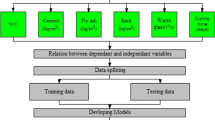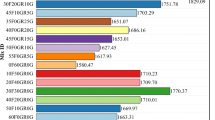Abstract
In the present industrial scenario, the production of fly ash being a waste from thermal power plants is increasing at an alarming rate. Fly ash not only creates a major problem at its disposal but also causes other environmental/health-related issues. To combat this waste is to find its application in the construction sector. In the past, fly ash is recognized as a promising replacement of clay in brick industry. The aim of the present work is to determine the characteristic compressive strength in a probabilistic approach for the Fal-G (fly ash–lime–gypsum) bricks constitutes the consumption of two waste products (fly ash and sludge lime) in brick manufacturing. For casting of Fal-G bricks, a semiautomatic, hydraulic operated brick manufacturing machine is fabricated and the compressive strength of the compacted bricks is observed. However, the compressive strength of the resulted bricks observed to be quite satisfied with the minimum value recommended as per IS 12894-1990. The study is further extended towards the fitting of randomly generated compressive strength values of Fal-G bricks to four different probability distribution functions and adopting Kolmogorov–Smirnov (KS) test to detect the best-fitted probability distribution of the present data. From the descriptive statistics of KS test results, it is inferred that the most common distribution, i.e. normal distribution, fits well to the data with the highest p value of 0.898. Normality test such as P–P and Q–Q plots is used to further confirm that the present data follow the normal distribution. Actual and expected z-scores are plotted to get all the data points on y = x line that follows the normal distribution. Determining the frequency factor of the normal distribution, the compressive strength is calculated at each probability level. At 95% probability level, the characteristic compressive strength of Fal-G bricks is obtained 4.8 N/mm2. Further, a curve fitting between a probability of exceedance and compressive strength shows logarithmic relationship which holds between the two variables with R2 = 0.932.






Similar content being viewed by others
References
Alaa S, Ali AM (2013) Manufacturing of bricks in the past, in the present and in the future: a state of the art review. Int J Adv Appl Sci 2:145–156
Ang AHS, Tang WH (2007) Probability concepts in engineering. Emphasis on applications to civil and environmental engineering, 2nd edn. Wiley, New York
ASTM international Standard, ASTM C 114-2007. Standard test methods for chemical analysis of hydraulic cement
Conte JP (2001) Statistics, probability and reliability. Course Univ Calif San Diego Fall 4:68–74
Eurocode 1 Basis of design and actions on structures, UNI-EN 1991-1 and UNI-EN 1991-2
IS 12894-2002 pulverized fly ash-lime bricks-specification. Bureau of Indian Standards, New Delhi, India
Kayali O (2005) High performance brick from flyash, 2005 world of coal ash (WOCA). Lexington, Kentucky
Kayali O, Shaw KJ. Manufactured articles from fly ash. Patent No. PCT/AU03/01533, Australia
Kumar S (2002) A perspective study on fly ash–lime–gypsum bricks and hollow blocks for low cost housing development. Constr Build Mater 16:519–525
Kumar V, Mathur M, Kharia PS (2003) Fly ash management: vision for the new millenium, technology information forecasting and assessment council, news and views, 25, March, 2003
Kumar R, Hooda N (2014) An experimental study on properties of fly ash bricks. Int J Res Aeronaut Mech Eng 2:56–67
Kumar R, Deepankar A, Najia L (2015) Properties of non conventional (fly ash) brick: an experimental study. Int J Eng Trends Technol 24:198–204
Melchers RE (1999) Structural reliability analysis and prediction, 2nd edn. Wiley, New York
Singh B, Kumar A (2016) A review paper on PLC based automatic fly ash brick machine. Int Res J Eng Technol 3(1):1274–1278
Zhang L (2013) Production of bricks from waste materials—a review. Constr Build Mater 47:643–655
Author information
Authors and Affiliations
Corresponding author
Rights and permissions
About this article
Cite this article
Priyadarshini, M., Patnaik, M. & Giri, J.P. A probabilistic approach for identification of compressive strength of fly ash bricks. Innov. Infrastruct. Solut. 3, 56 (2018). https://doi.org/10.1007/s41062-018-0162-3
Received:
Accepted:
Published:
DOI: https://doi.org/10.1007/s41062-018-0162-3




